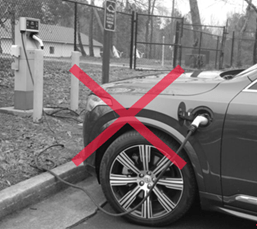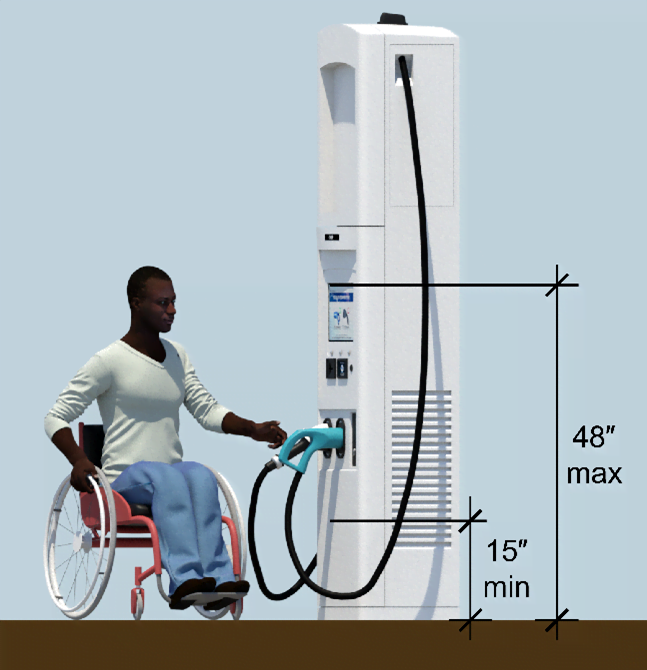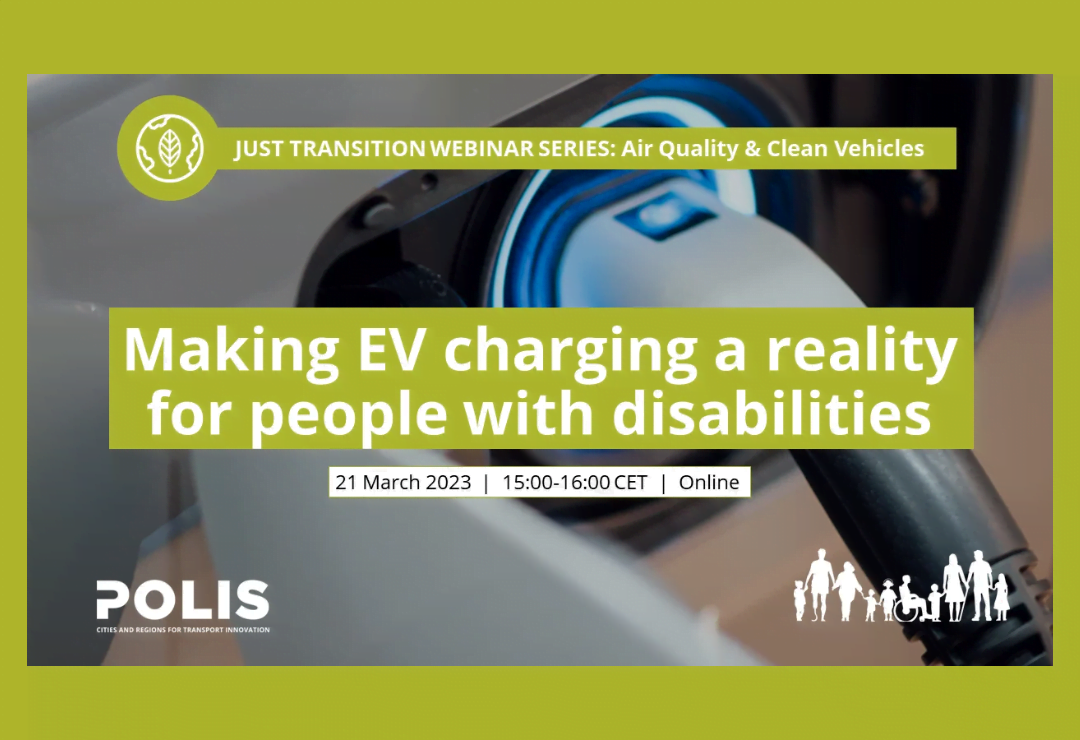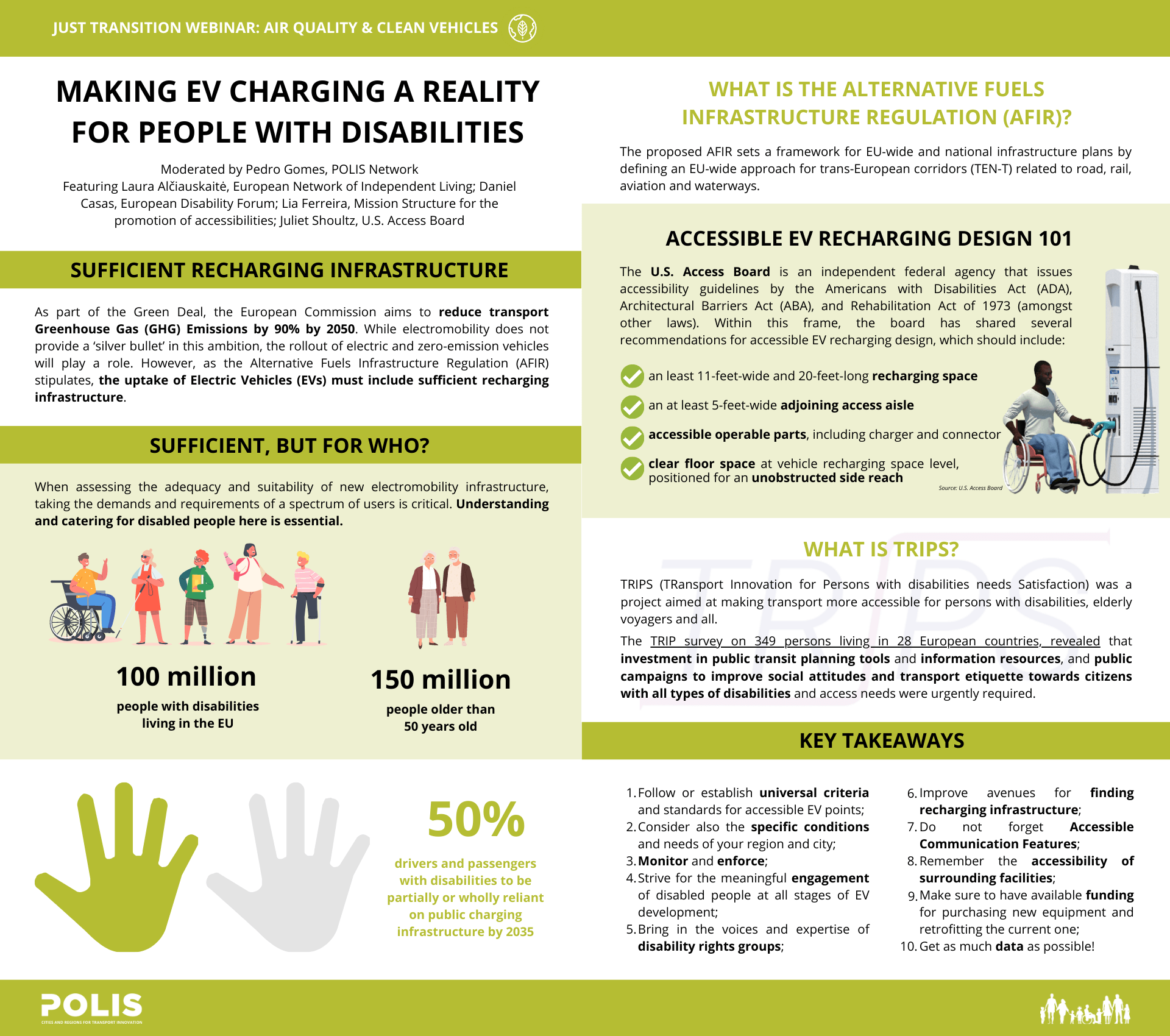POLIS' Just Transition Webinar explores EV charging for all
As electric vehicles are rolled out quicker than ever before, guaranteeing accessibility of recharging infrastructure is critical to ensuring some of those most reliant on cars are not locked out of the shift to cleaner fuels. POLIS' Just Transition webinar series brought together experts to explain more.
The race is on. As part of the Green Deal, the European Commission aims to reduce transport Greenhouse Gas (GHG) Emissions by 90% by 2050. While electromobility does not provide a ‘silver bullet’ in this ambition, the rollout of electric and zero-emission vehicles will play a role.
Progress in international policy here appears to be underway and the recent sales ban on new internal combustion engine-powered (ICE) vehicles from 2035 onwards suggests electrification is accelerating… fast! However, as the Alternative Fuels Infrastructure Regulation (AFIR) stipulates, the uptake of Electric Vehicles (EVs) must include sufficient recharging infrastructure. So, WHAT really is “sufficient”? And WHO is it sufficient for?
This is a topic POLIS, through the Clean Vehicles and Air Quality Working Group has explored in depth previously- investigating the actions playing out on the ground in our European cities and regions. To examine this issue further, POLIS’ Just Transition webinar brought together experts from the U.S. Access Board and ENIL - European Network on Independent Living to present inspiring examples, followed by a panel discussion with representatives from the European Disability Forum and the Portuguese Mission Structure for the Promotion of Accessibility.
What is the Alternative Fuels Infrastructure Regulation (AFIR)?
The proposed AFIR sets a framework for EU-wide and national infrastructure plans by defining an EU-wide approach for trans-European corridors (TEN-T) related to road, rail, aviation and waterways.

On-Street EV Recharging Station Design. Left, an accessible design with a lowered curb. Source: U.S. Access Board, https://www.access-board.gov/tad/ev/
The AFIR sends the right signals to meet the EV demand on the roads. The sales of EVs in the EU continue to grow. Combined with the proposed ban on sales of internal combustion engines by 2035, it is key to speed up the roll-out of recharging infrastructure across Member States. This will require the deployment of operational and accessible recharging points where they are needed, and capable of delivering the right power output. Combining fleet-based targets with distance-based targets on the TEN-T ensures that the roll-out of recharging stations matches the uptake of EVs.
It also seeks to ensure coherence in the approach member states use to handle national, regional and sub-regional specificities related to the transport modes via their National Policy Frameworks.
However, as the webinar panel explored, there is a clear capacity to develop standards further, particularly around the focus afforded to accessibility.
Measuring and monitoring accessible recharging: accessibility guidelines

An inaccessible parking station where the curb is a barrier to a disabled person accessing the charger. Source: U.S. Access Board, https://www.access-board.gov/tad/ev/
Research has estimated that 34% of disabled drivers or passengers (0.93 million people) will not have access to off-street parking at their own homes and will be dependent on on-street or public recharging infrastructure.
As a result, attention to the design of such infrastructure is essential if disability rights are to be truly mainstreamed into the future of electromobility.
To explore how such standards can be measured and implemented, Juliet Shoultz, from the U.S. Access Board, presented the Design Recommendations for Accessible Electric Vehicle Charging Stations, a technical assistance document to assist in the design and construction of electric vehicle (EV) recharging stations that are accessible to and usable by people with disabilities.
She walked participants through each detail of an EV recharging station, and how each operable part, location and system design can be adapted to be more accessible.
Co-designing accessible transport: what, where, when and how?
Developing standards and specifications requires working with disabled people themselves, and co-designing processes, and services.
“Independent Living means freedom of choice, it is not living by yourself, it is control over how you live and this includes the right to travel freely, regardless of access needs,” asserted Laura Alčiauskaitė, ENIL.
“When you work together, you create services which people can use; this can be a complex process, but it is worth it.”

An accessible EV recharging point. All operable parts should meet the requirements for unobstructed side reach. Source: U.S. Access Board
European Network on Independent Living (ENIL) is a user-led network of disabled people, with members throughout Europe who were partners in the TRIPS project. They advocate for Independent Living values, principles and practices: provision of personal assistance and other community supports and services, a barrier-free environment and adequate technical aids, together making full citizenship of disabled people possible.
TRIPS (TRansport Innovation for Persons with disabilities needs Satisfaction) is a project which aimed to make transport more accessible for persons with disabilities, elderly voyagers and really everyone- bringing together 7 groups of persons with disabilities located in 7 European cities and 11 institutional partners spread across 10 countries.
The project revealed that in all the pilot cities, disabled passengers are still restricted in many aspects when it comes to choosing public transportation. Moreover, people living in the largest cities still have more options than disabled people living in more remote or rural areas.
You can read the full report in the PDF attached

